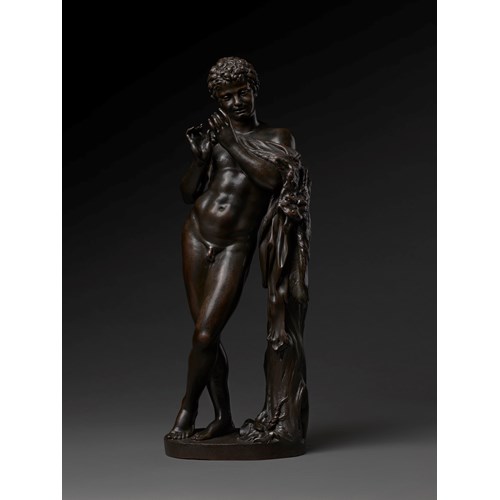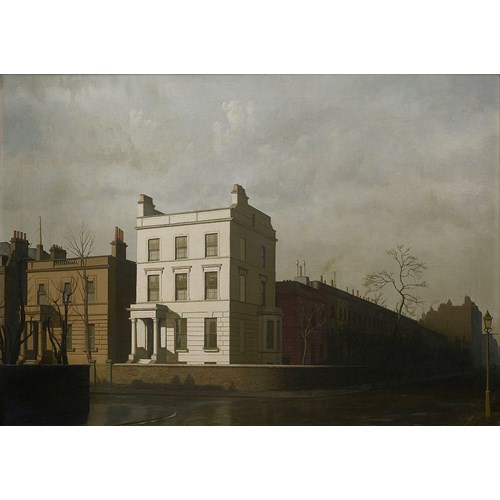Marketplace
Hermes, 1988
Robert Mapplethorpe
Hermes, 1988
Date 1988
Medium Gelatine silver print
Dimension 48.3 x 48.3 cm (19⁰/₁ x 19⁰/₁ inches)
Since his death in 1989, Robert Mapplethorpe has become recognised as one of the most significant artists of the late 20th century. He is best known for his perfectly composed photographs that explore gender, race, and sexuality, which became hallmarks of the period and exerted a powerful influence on his contemporaries.
After studying drawing, painting and sculpture at the Pratt Institute in the 1960s, Mapplethorpe began experimenting with photography while living in the notorious Chelsea Hotel with the American muscican, Patti Smith, with whom he had started a relationship. Beginning with Polaroids, he soon moved on to a Hasselblad medium-format camera, shooting almost exclusively in black and white, which he used to explore aspects of human and still life; most notably, intimacy and sexuality.
During the latter half of the 1970s, Mapplethorpe began to experience increasing career success, photographing celebrities and members of high society in America and abroad. Much of his portrait photography was devoted to close friends and lovers, especially those from the BDSM and LGBT scene which began to proliferate in New York at this time.
By the 1980s, Mapplethorpe's focus was predominantly in his studio where he perfected classical aesthetic standards, primarily photograping portraits, flowers and nudes. His depiction of the human form in formal compositions reflected his love of classical sculpture and his groundbreaking marriage of those aesthetics with often challenging subject matter. Mapplethorpe's style is still relevant regardless — from erotic nudes to self-portraits and flowers — he ceaselessly strove for what he called "perfection of form."
The present work depicts a marble head of the Greek messenger god, Hermes, in profile. Renowned for his youthful features and beauty, it is no surprise that Mapplethorpe chose this subject matter. The success of the composition lies in the severity of the outline of his face against the stark black backdrop, allowing us to marvel at his facial features. It effectively shows Mapplethorpe’s technical and formal mastery of black and white photography, his understanding of aperture control and perfecting composition.
In 1986, Mapplethorpe was diagnosed with AIDS. Despite his illness, he accelerated his creative efforts, broadened the scope of his photographic inquiry, and accepted increasingly challenging commissions. The Whitney Museum of American Art mounted his first major American museum retrospective in 1988. In the same year, he established the Robert Mapplethorpe Foundation to promote photography, support museums that exhibit photographic art, and to fund medical research in the fight against AIDS and HIV-related infection. Mapplethorpe succumbed to the illness in 1989.
After studying drawing, painting and sculpture at the Pratt Institute in the 1960s, Mapplethorpe began experimenting with photography while living in the notorious Chelsea Hotel with the American muscican, Patti Smith, with whom he had started a relationship. Beginning with Polaroids, he soon moved on to a Hasselblad medium-format camera, shooting almost exclusively in black and white, which he used to explore aspects of human and still life; most notably, intimacy and sexuality.
During the latter half of the 1970s, Mapplethorpe began to experience increasing career success, photographing celebrities and members of high society in America and abroad. Much of his portrait photography was devoted to close friends and lovers, especially those from the BDSM and LGBT scene which began to proliferate in New York at this time.
By the 1980s, Mapplethorpe's focus was predominantly in his studio where he perfected classical aesthetic standards, primarily photograping portraits, flowers and nudes. His depiction of the human form in formal compositions reflected his love of classical sculpture and his groundbreaking marriage of those aesthetics with often challenging subject matter. Mapplethorpe's style is still relevant regardless — from erotic nudes to self-portraits and flowers — he ceaselessly strove for what he called "perfection of form."
The present work depicts a marble head of the Greek messenger god, Hermes, in profile. Renowned for his youthful features and beauty, it is no surprise that Mapplethorpe chose this subject matter. The success of the composition lies in the severity of the outline of his face against the stark black backdrop, allowing us to marvel at his facial features. It effectively shows Mapplethorpe’s technical and formal mastery of black and white photography, his understanding of aperture control and perfecting composition.
In 1986, Mapplethorpe was diagnosed with AIDS. Despite his illness, he accelerated his creative efforts, broadened the scope of his photographic inquiry, and accepted increasingly challenging commissions. The Whitney Museum of American Art mounted his first major American museum retrospective in 1988. In the same year, he established the Robert Mapplethorpe Foundation to promote photography, support museums that exhibit photographic art, and to fund medical research in the fight against AIDS and HIV-related infection. Mapplethorpe succumbed to the illness in 1989.
Date: 1988
Medium: Gelatine silver print
Signature: Signed, dated and stamped with copyright credit ink stamp on reverse of mount
Dimension: 48.3 x 48.3 cm (19⁰/₁ x 19⁰/₁ inches)
Provenance: Robert Miller Gallery, New York
Private Collection
Hamiltons Gallery, London
London Art Market, to 2024
Acquired from the above.
Exhibition: Robert Miller Gallery, New York
Hamiltons Gallery, London
Plus d'œuvres d'art de la Galerie









